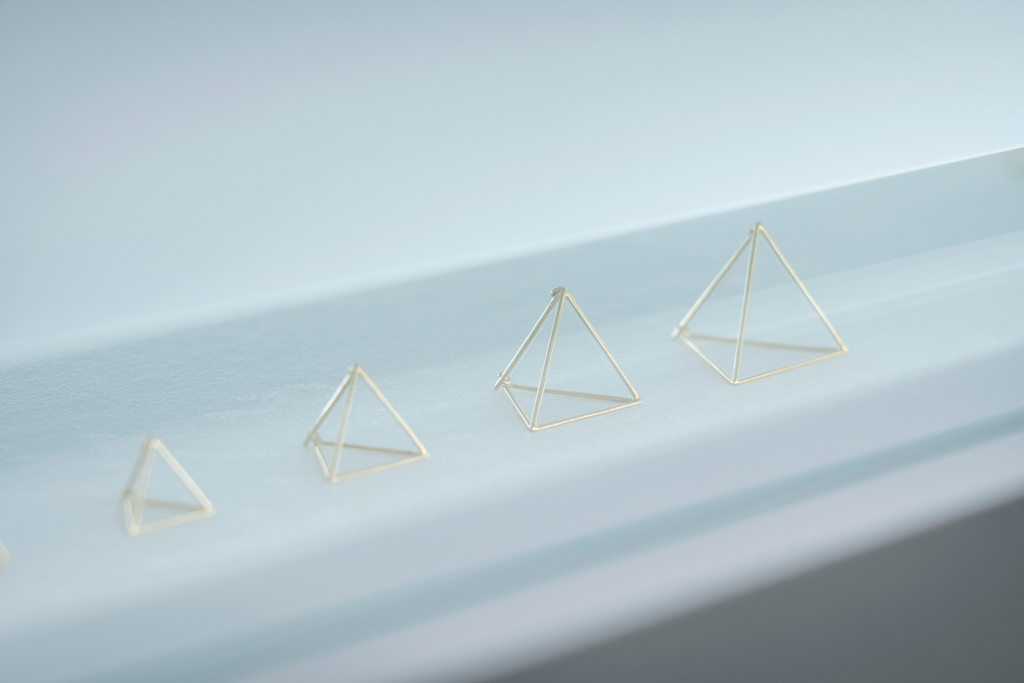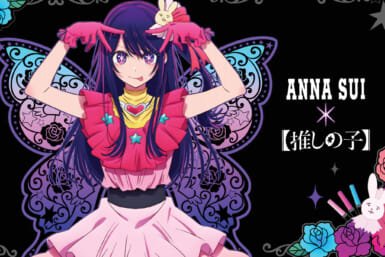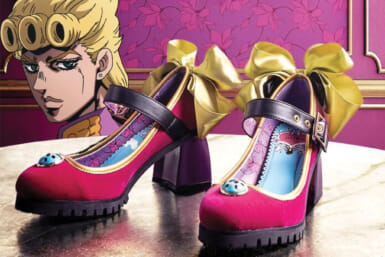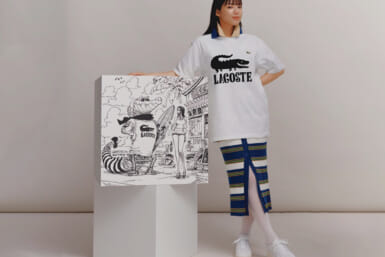Handling the minimalist yet intricate jewelry pieces of Shihara never fails to unveil hidden features and treasures. Necklaces designed without conventional clasps, where the fastening contraption is integrated into the design, or functional parts of earrings such as catches and posts used as part of the overall design, are just a few examples of the many innovative creations of Shihara.
The designer behind the brand is Yuta Ishihara, 35, who currently lives and works in Tokyo. His design philosophy considers jewelry from a theoretical standpoint, while updating the conventional rules, functions and structure of jewelry into a cleaner, streamlined and beautiful design. “Jewelry could be viewed as something that people wear to ornament or decorate themselves, but my designs, which often have multiple options for how they can be worn, are meant to bring out and highlight the beauty of the wearer’s personality,” he says.
Ishihara does not design for a specific gender or age group in mind. “With minimal decorative elements, the unconventional yet functional structures seamlessly connect the body to enhance beauty. Therefore, I intended it to be accessible to all as far as age and gender are concerned,” he adds.
Design and Materials
For his Shihara label, Ishihara exclusively works with yellow gold and two white metals: white gold and platinum. “My favorite material is actually yellow gold and I especially like using 18K gold,” he says. However, most of his pieces are also available in platinum and white gold. “My pieces tend to be smaller and more delicate, so the material needs to be strong enough to maintain its shape but also be delicate enough to create the fine lines that I want. I see a lot of potential for gold in the way that it is processed and the way that it can be used while mixing metals can make the material stronger than we believe it to be. Silver tends to be too soft for the designs I want to create.”
Ishihara’s jewelry design is about incorporating the hardware and fittings into the designs of the pieces. “Hardware such as necklace clasps, earring posts are often standardized, and its designs and functionalities are rarely addressed,” he says.
“However, this also means that I end up re-defining the functions and wearability of jewelry. When I design, I like to reexamine the functionalities of the hardware and incorporate that function into the design by re-defining and reimagining the way it is worn,” he continues.
He describes, as an example, his 3D earring series. They are delicate structures shaped like cubes, pyramids and rectangles that come in small, medium or large sizes. “The post of the earring is concealed within the design of the 3D geometric forms so when the earring is worn, you cannot see the post itself.”
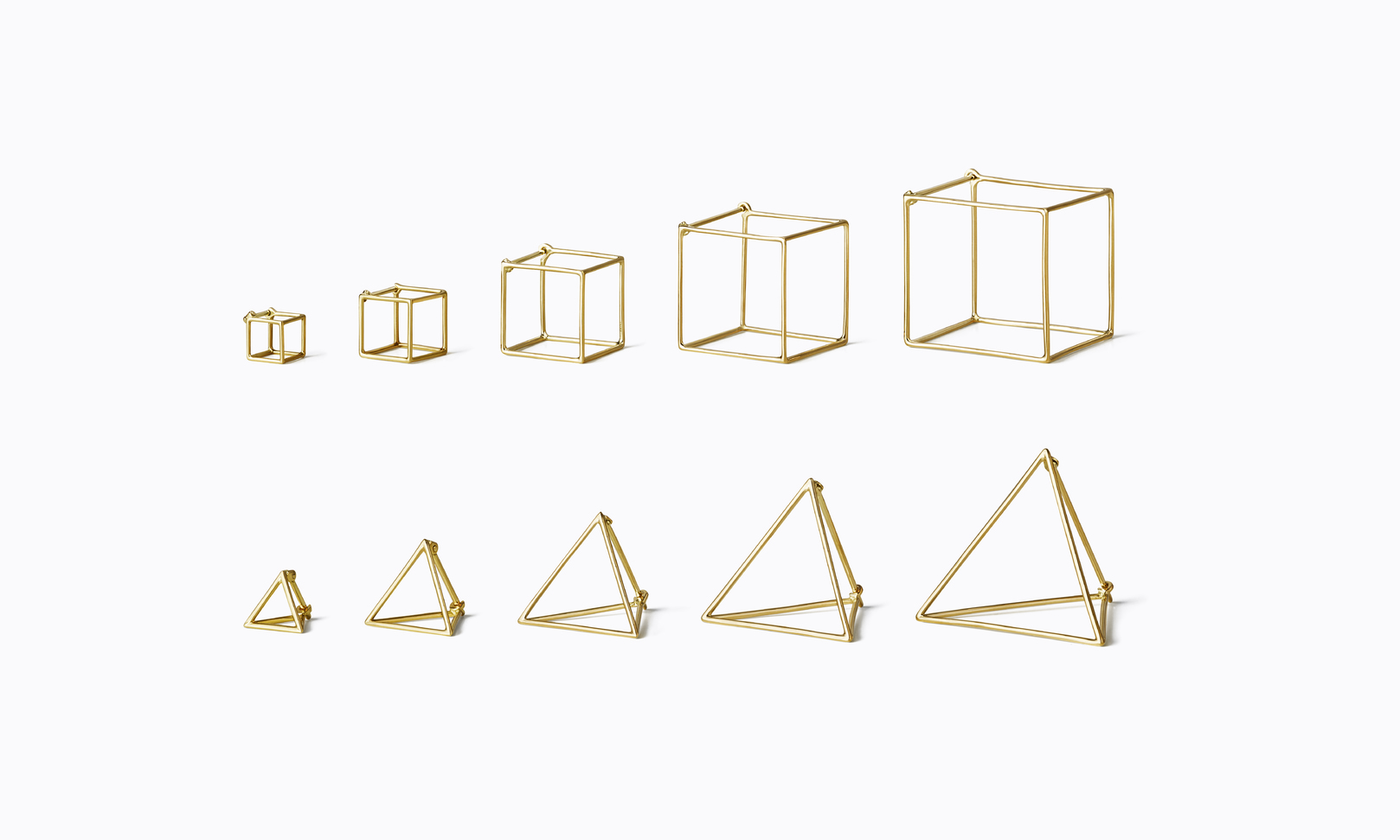
Shihara 3D earrings
On those designs, one side of the three-dimensional form opens up as a post. The appearance of the earring changes depending on where the center of gravity is placed. When worn on the ear, at any level, it looks as if a three-dimensional structure is enveloping it.
For his One Stone necklace, a gold chain adorned with a sophisticated round-shaped pendant paved with diamonds, he designed a special clasp that is hidden under the diamond. “It allows the necklace to have a clean minimal look where the clasp is not visible at all,” he says.
This way, the person who wears it doesn’t have to keep fidgeting throughout the day, turning the chain around their neck to make sure the clasp is not visible.
Another one of his favorite pieces is the Bond ring series, individual diamond-adorned rings that can be worn on their own or stacked with others — a bit like a puzzle or Tetris game. “The Bond ring series was specifically designed as a stacking ring but instead of having the rings stack on top of each other, I designed them to be worn interlocking into each other,” he comments.
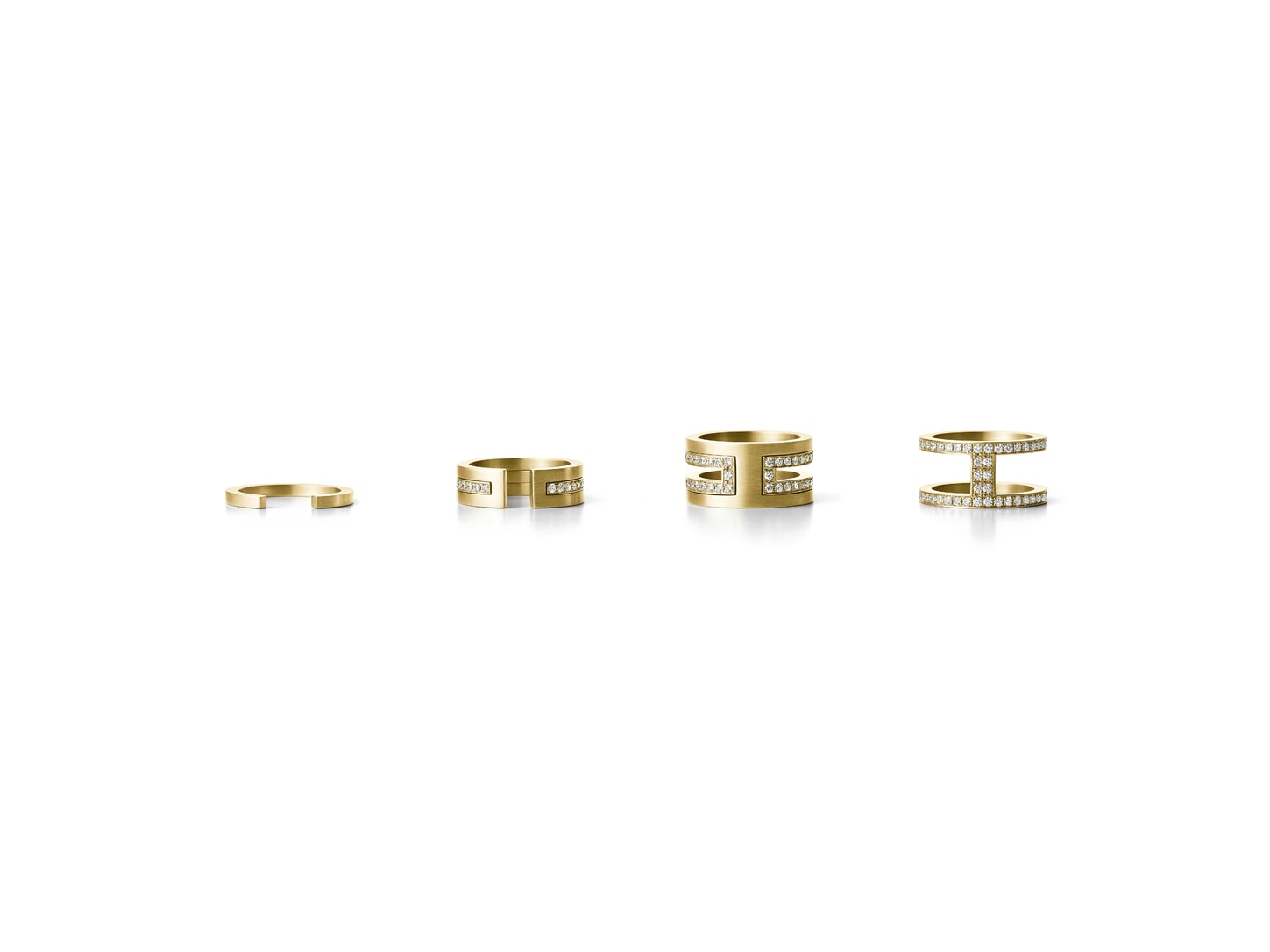
Shihara Bond rings
Ishihara works with individual craftsmen and companies located in both Tokyo and Yamanashi, a prefecture known for jewelry manufacturing and craftsmanship. In fact, Yamanashi is the most important jewelry producer in Japan, due to the presence of rock crystal in its northern mountains and overall rich geology. Yamanashi is also where Ishihara was born and raised. But unlike most of his classmates, he decided to leave when it came time to pursue higher education. “Back then, I discussed it with my family and we decided there would be more opportunities in Tokyo. If I had gone to school in Yamanashi, I would have stayed there, and I don’t think things would be where they are now,” he says.
Bricks and Mortar
Arriving in Tokyo, he enrolled in a three-year program at Hiko Mizuno College of Jewelry and graduated in 2007. “I decided to stay in Tokyo and took personal orders from friends to create custom-made wedding jewelry,” he adds. The affable creative officially launched Shihara in 2010, when he was just 23 years old.
In 2014, the brand’s first flagship store, Shihara Lab, opened in Harajuku on a quiet street behind the main Omotesando boulevard. It’s an intimate space with a concrete interior and a large mirror. The walls are equipped with magnets to vertically display the jewelry, which also saves space and makes it easy to change the displays at any time.
In 2015, Ishihara started working with a UK-based showroom that took on US and Asian markets and that’s when he started selling internationally. Shihara is now sold at over 300 retailers all over the world, including Farfetch and SSense.

Shihara Dover Street Market Ginza
There is another Shihara store in Osaka and in March 2022, a permanent Shihara space featuring large white chests of drawers opened at Dover Street Market Ginza. Referring to that particular concept, Ishihara says, “it was based on an idea drawn from specimen drawers you would see at an archeological lab or natural history museum.”
When asked about how he feels about the rapid growth of Shihara, he adds he was surprised by its international success. “I wasn’t thinking that far ahead back when I started,” he says.
Yutai
When the coronavirus pandemic hit back in 2020, it gave Ishihara an opportunity to focus more on the fine jewelry brand Yutai, his other collection. Both Shihara and Yutai are word plays on his name: Since his first brand was named Shihara, not using the i from his last name, he decided to add that i to his first name to create Yutai, so it’s all connected. To design the one-of-a-kind pieces of Yutai, he uses durable precious metals (again with Yutai he only works with yellow and white gold, and platinum) but also gemstones such as lemon quartz, blue topaz and pearls. He also gives a new life to dated setting styles that were crafted in Yamanashi Prefecture with his Revive Rings, using traditional decorative cocktail ring settings that have been lifted from their original bands and replaced onto modern, wide-banded rings, giving an antiquated style a facelift.
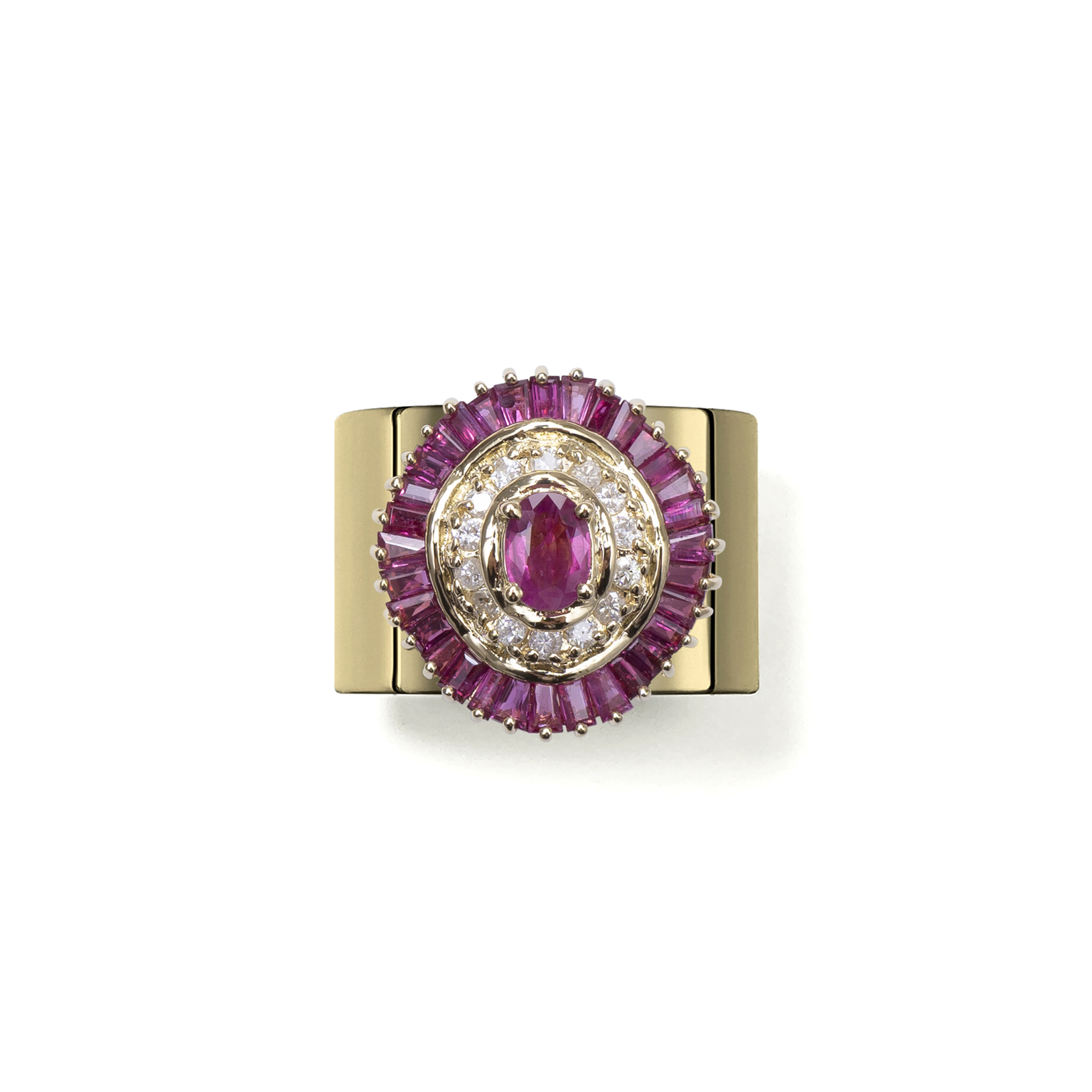
Yutai Revive ring
The stability of his Shihara brand helped him finance his second brand. He appreciates the flexibility of switching between creating the different styles. “With Shihara, we work with materials that can be replicated so we can produce pieces on demand,” he says. (For example, some things are already in stock at the shop, while other items have to be made-to-order.) “But with Yutai,” he adds, “what you see is what you get.” Rihanna has been photographed wearing the jade version of the Yutai Sectional necklace. This piece takes the familiar single-strand pearl necklace but splices in sections of other materials, polished and hand-hammered to match the shape of the pearls, such as jade or ruby gemstones. “Each piece is unique,” he says. Just like for his Shihara collection, the clasp, hidden within the strand, mirrors the shape of the pearls and is fastened with a keyhole-shaped mechanism.
“I actually started designing this collection in 2012, and over the years I kept adding pieces to it,” Ishihara says. He launched Yutai in December 2021 at Bergdorf Goodman in New York and at Dover Street Market in Ginza, in spring 2022. “Since these are all one-of-a-kind pieces, we can’t launch them at different places at the same time. Depending on the material, some things can be made similar to the pieces we have, but some things cannot be recreated, and natural materials always differ from one another.”
“For Yutai, more process goes into it, but the background of Shihara helped me, and made me stable enough to focus on this brand,” he comments. “At markets, materials often have to be bought in cash, so you really have to have a stable background business. It would have been very difficult to launch Yutai without the Shihara background. Everything I build is 100 percent with my own money.”

